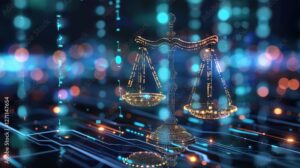Girl….. Technology is NOT all that!!
Thanks to Sarada and Chi for being our opposing side of this argument. They were able to give many great points to sway the pre and post vote😊 They argued that technology plays an important role in breaking down barriers from geography and income. By expanding essential services such as healthcare and education technology gives resources to a broader population. An example is virtual classrooms for remote Indigenous communities in Canada.

The article they posted “The impact of technological advancement on culture and society” did a great job showing the relationship and challenges between technological advancement and cultural transformation. I liked how they argued that technology can empower marginalized communities especially in indigenous communities. I think this is actually quite great even though I am on the opposing team…… Great job ladies

NOW to our side…..Dani and I presented a compelling case that technology has NOT led to a more equitable society. Instead, we argued that it has only deepened existing divisions and introduced new forms of exclusion.
Our core argument centered on the crucial distinction between equality and equity. While equality might mean giving everyone the same resources, like identical textbooks, equity focuses on fairness, providing individuals with what they individually need to succeed.
We argues that the digital divide is equity crisis. We wanted to reflect deeper societal issues like economic status, geographic location, digital skills, and social exclusion. We used the COVID-19 pandemic as an example of how technology worsened inequality, especially in education. Our argument was that students from higher-income homes benefited from faster internet, newer devices, quiet workspaces, and tech-savvy parents while students in marginalized communities often had none of these essential supports. The the students from low-income households, rural and Indigenous communities, and under-resourced schools are examples of the digital divide and how covid only made this divide worse.
We recognized that technology is created by people, often those with privilege, and it reflects their inherent biases. This means that while there might be tools trying to improve access, the overall result is that the privileged continue to benefit first and most, while the marginalized are continuously left behind. We also recognized that technology is a powerful tool. I especially recognized Dustin’s thought on using it for mental health. I absolutely agree with 100% that in a mental heath aspect of healthcare, it absolutely could close the access gap!!! However, I still am on the side that overall technology benefits some and not others. Technology, causes a massive divide in our society and does NOT lead to a more equitable society.
Hope everyone can enjoy the remainder of summer and looks like it should be a beautiful and sunny day!!



Hi Jillian,
Thanks for your thougthful post and for a great debate this week! I remember Rose saying that during Covid her school only had 10% participation in online learning and I thought that was a very low number! When I look back at my own experiences during that time, my school experienced about 30% participation but my own kid’s school reported closer to 80% participation. Other schools avoided online teaching because they knew their population didn’t have access to technology so teachers prepared work packages for families instead. That was such a crazy time for everyone so I don’t know if it’s fair, after 5 years, to keep comparing what is happening now to what was happening then. I would argue that because of Covid, worldwide access to technology actually improved because we could see very clearly where the inequalities were and there was a tangible way to fix those inequalities (necessity is the mother of invention). Now, I’m not saying that there is no inequity but I definitely think that since Covid, the gap has been closing across the globe.
Thanks again for your great debate and I hope you have a great rest of your summer!
Carol, you make a really good point. I had not thought about how much time has passed, like five full years since COVID began, and how we are still comparing the way things were then to how they are now. I honestly had not looked at it from that perspective, and I really appreciate you bringing up that point:)
Great response! I really appreciated reading your take on both sides of the debate. Sarada and Chi definitely presented compelling examples, like the use of virtual classrooms in remote Indigenous communities that showed how technology can be a powerful equalizer when implemented thoughtfully and with the right supports in place. That said, I thought we did a good job clearly explaining the difference between equality and equity. That distinction is so important and often overlooked in conversations around tech access.
I also liked how you acknowledged the potential of technology in specific areas like mental health, while still recognizing that, overall, tech tends to benefit those who already have privilege.
We all presented thoughtful, well-researched perspectives, and I think this debate really highlighted the complexities of technology’s role in creating a more equitable society, or not. Great job and thank you for being such a wonderful partner to work with!!!!
Dani, it was such a pleasure working with you. I am someone who can admit when I might have missed the mark, and I have to say, the other side really helped me see just how significant the gap is when it comes to mental health. If technology can help bridge that gap, then I fully support it, even if it means being on the opposite side of our original stance. I really enjoyed diving into the research with you. We explored our topic deeply and worked well together. Wishing you a wonderful summer.
Thanks for sharing your take on whether skills like cursive writing, multiplication tables, and traditional spelling remain relevant in a tech-shifting classroom Jillian!
Similar to your conclusion, I believe that these foundational skills still play a critical role in student development, not as technophobia, but as necessary groundwork. When students rely solely on spell-check or calculators, they often miss internalizing the reasoning behind the results, a nuance that tech can’t fully replicate.
You captured it beautifully when you described how foundational skills shape deeper learning and confidence, even as we integrate digital tools. I wholeheartedly agree that it’s not about rejecting technology, but about blending tradition and innovation in meaningful ways.
Thanks again for sharing!
Your argument was powerful and well-reasoned. I really appreciated how you and Dani highlighted the difference between equality and equity—it’s such an important distinction. Using COVID-19 as an example made the digital divide feel very real and relatable. Your point about tech reflecting privilege really stood out.
You and Dani presented some really great points in this debate… I found myself swaying back and forth between seeing the positivity technology can have on our marginalized communities, but also the digital divide that exists. I really liked your statement that potential does not always equate to progress for ALL. We definitely have a long way to go!!
Thank you for your thoughtful reflection Jillian!
I appreciate the commentary about how technology is closing the gap in our northern communities by providing access. Yes, this is changing society (however slowly) to reflect equality.
Now, I am on the side of technology continuing to exploit the inequity and inequality of society. As helpful as these small steps toward equality are, they are still not moving the needle enough to make a true difference. Yes, we have more access to technology than ever, but, as you mentioned, these are normally for those who are in a privileged position. Those who are not have other, more pressing, concerns.
If we look at tech that is helping improve access and connection for those with disabilities, we again see that it is normally those who are privileged who have the better access to it. With that being said, this only deals with the equality of access, not the equity of access. While access to the internet, computers, and gadgets, it does not include the technology that could revolutionize a child’s life. I mentioned in another post the work that the U of C is doing with the BCI program. This program, which is lifechanging for some children, is only available to Calgary area residents.
Our need of progress is slow and extremely unfocused on equity. Thank you for your thoughtful debate and reflection!
Hi Jillian,
Great job with your debate this week!
You and Danielle made a compelling case that really challenged me to think more critically about the assumptions I hold around technology and equity. I appreciated your clear explanation of the difference between equality and equity. It’s such an important distinction, and one that is often overlooked in discussions about digital access. Your example of the COVID-19 pandemic was especially striking, as it highlighted how access to technology isn’t just about having a device, but about having the right supports in place, like reliable internet, a quiet space, and caregivers who can assist with technology. The digital divide you described is real, and it does reflect deeper systemic issues that technology alone can’t fix.
What stood out most for me was your point about who creates technology and whose needs it actually serves. You are absolutely right, technology is not neutral. It is developed by people with their own beliefs and worldviews and often ends up reinforcing the very inequities it claims to solve. Your post reminded me that we can’t just focus on the tools themselves; we need to examine the structures behind them. While I do see potential for technology to increase equity in some areas, like mental health access, as you acknowledged—it is clear that without intentional, systemic change, those benefits won’t reach everyone.
Thank you for sharing your perspective so clearly and passionately.
Leanne